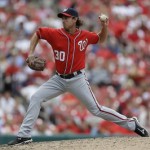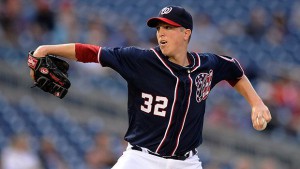Another edition of mlb.com’s Nationals beat reporter Bill Ladson’s Inbox, this time from 12/18/12.
As always, I write my response before reading his, and sometimes edit questions for clarity.
Q: Who will replace Sean Burnett as the lefty specialist in the bullpen?
Q: Is there any chance of the Nationals getting J.P. Howell to fill Burnett’s spot? Do you think the club needs him?
A: The Nats 2013 Loogy right now is likely to be minor league acquiree and former franchise 1st round pick Bill Bray. If he’s healthy, and if he makes the team. He’s the leader in the clubhouse right now, given the real lack of left handed relief in the farm system right now. Clicking on baseball-reference’s great franchise pitching depth chart, there’s really not a single viable option that pitched above AA still in the system (I like Patrick McCoy, who did decently in AA, but he wasn’t picked up in Rule 5, which implies to me that he’s definitely not MLB ready). Zach Duke seems set to be the Tom Gorzelanny replacement; the long-relief/spot-start/mop-up guy, and not necessarily the one-out guy. The team is still involved with rumors of signing J.P. Howell, and of course could still re-sign Michael Gonzalez, who did so wonderfully for is in 2012. However, lots of teams are in on lefty specialists right now and we may get out-bid. I’m partial to Bray; he is a Virginia guy, went to William & Mary, and is the cousin of a buddy of mine (who, when I saw him last weekend, promised to have access to tickets if Bray makes the team). Lets cross our fingers (stated completely selfishly).
Do we “need” Howell/Gonzalez? I don’t know if we “need” another lefty, but I’d like another lefty in case Bray isn’t ready to go. So I’d like to see another acquisition of someone for depth. I think the bullpen looks better with a second lefty late-innings guy. Ladson wrote almost exactly what I just wrote, naming all the same points.
Q: When looking at the 40-man roster, could you tell me what Yunesky Maya has to offer?
A: Maya still serves as last-ditch starter help, in case of a rash of injuries at the MLB level. Despite his poor performances in two prior MLB stints, he’d still be preferable to other career minor league veteran options we probably will have in AAA this year (thinking the likes of Roark, Broderick, or Mandel). His salary is guaranteed; we might as well keep him around as insurance. If you’re looking to complain about a 40-man spot being wasted, look no further than Carlos Rivero. Ladson calls the Maya signing Mike Rizzo‘s worst, and says the same thing I do about starter insurance.
Q: Who do you think has more of an upside: Michael Morse or Adam LaRoche?
A: An oddly worded question; I’m not sure either guy truly has upside at this point in their careers. Michael Morse is in the last year of a contract, his sub-par defense has him outside of Rizzo’s vision of a pro-defense team, and there’s no guarantee that his 31 homer performance in 2011 wasn’t a complete one-off. Adam LaRoche is already in his decline years and any guaranteed money is considered a big risk. The best thing to do for the team would be to get LaRoche to return on as short of a guaranteed contract as he’ll take, and to flip Morse for some farm system depth (vastly depleted in the last 14 calendar months). But, life isn’t that simple. LaRoche has to be thinking for himself, and knows that this is the best and last time he’ll have to earn an 8-figure guaranteed deal. So he has to max things out. If someone else offers him 3 guaranteed years, he just has to take it. He’ll never get $13M/year offered to him again. Which would leave Morse in a contract year playing an easier defensive position (1B), and hopefully being 100% healthy he puts up another 2011 season. Ladson is a pro-LaRoche guy.
Q: Considering his last outing in the postseason against the Cardinals, is Drew Storen the Nationals’ closer entering Spring Training, or will he have to win the job?
A: One badly timed blow-up won’t cost Drew Storen his job; he earned it back after taking a back seat to Tyler Clippard all summer, and that’s how things will stand going into 2013. Clippard really struggled down the stretch in the role, and I cannot see any spring training competition at this point. One thing that wouldn’t surprise me would be a trade though; only one guy can close, but both Clippard and Storen are closer-quality arms. It could be lucrative to the team in terms of prospect depth to move one or the other to a team in need of a closer (and a team that values saves). This move may not occur until next off-season though, when Clippard’s salary expectations will be far higher than the team may be willing to stomach for a non-closer. Ladson says he expects Storen to be 100% and to get 30-35 saves.
Q: Burnett, who was a valuable asset in the bullpen, signed a two-year deal with the Angels. Couldn’t the Nationals have matched that kind of deal?
A: Yes they could have matched the Angel’s offer for Sean Burnett; it really wasn’t that much money. But, by saving a few million here and there suddenly you have enough to buy a front-line starter. That’s the right way to build a team in a fiscally responsible way. That being said, I think perhaps the team was surprised that Burnett “only” signed a 2 year deal, given Jeremy Affeldt‘s 3 year contract for more money (Burnett’s deal has a 3rd year club option). But Rizzo belives in the same thing that I believe in; bullpen arms are a commodity, can be found for relatively little money and you can get great performance for your dollar. Think about Gonzalez last year; he was a minor league signing mid-season, and he posted a 132 ERA+ for us in 35 2/3 innings. I think Bray could absolutely be this year’s version of Gonzalez. Ladson has a good point: he thinks the Nats were slightly scared off by Burnett’s off -season elbow surgery and didn’t want to guarantee 2 years.
Q: Johnson’s favoritism drives me crazy, and I’m weary of reading about him trying to coax LaRoche into signing. Doesn’t favoritism bother the rest of the team, perhaps cause discord? And does the ballclub truly believe LaRoche can achieve the same numbers next year? I am dubious.
A: A great question; I’ve said in the past that Davey Johnson‘s overt recruiting of LaRoche in the media has to be grating to Morse. If LaRoche signs elsewhere, I would absolutely believe there may be some discord in the clubhouse between Morse and Johnson that will need to be addressed. Other readers on this blog don’t necessarily believe this is the case, saying that Morse has to know that “its a business.” But how would you feel if your boss was overtly recruiting your replacement? I’d be pissed. Can LaRoche match his 2012 numbers in 2013? Sure. The odds are against him though. Its more likely to expect declines in production natural with his advancing age. Ladson says the players love Johnson and would never question him, but didn’t even mention Morse’s name.
Q: Do you think Ian Desmond can pull off another incredible year in 2013?
A: Sure! Do I think Ian Desmond could also regress at the plate to his pre 2012 numbers? Yes I do. I really have no idea what to expect out of guys like Desmond and Roger Bernadina, who both had career years and significantly improved their offense over their career norms. Are these one-time improvements? Meanwhile, a guy like Danny Espinosa is in the reverse situation; he’s regressing year to year, and needs to make a leap like Desmond made. Predictions? I think all three players stay roughly where they are, Espinosa starts losing ABs against lefties to Lombardozzi, and Rendon starts to force the team’s hand by tearing up AAA in early 2013. Ladson is really pro-Desmond, saying that he’ll go down as one of the great short-stops in baseball. That’s heavy praise.





